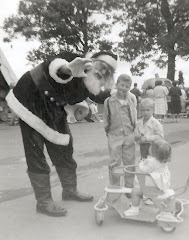 With Christmas just about a month away I like to take the time to stop and reflect about just who I am portraying and what it really means to be Santa Claus. You see, Santa Claus is real, more than one might expect and has been around a long time.
With Christmas just about a month away I like to take the time to stop and reflect about just who I am portraying and what it really means to be Santa Claus. You see, Santa Claus is real, more than one might expect and has been around a long time.Ask any child what Santa looks like, and he or she can probably describe him – he’s a big guy with a white beard, a red suit and hat, and a reindeer-drawn sleigh. But how did the gift-giving habits of Nicholas, a Christian saint who lived in the third century, evolve into the myth of a jolly old elf that slides down chimneys?
Two people, political cartoonist Thomas Nast and author Clement C. Moore can largely take credit for popularizing today’s image of Santa as a jolly, rotund fellow who wears a fur-trimmed red suit. But the evolution from St. Nicholas to the image of today’s Santa occurred over a long period.
 Nicholas was born in 270 AD in what is now Turkey. His parents were wealthy, devout Christians who died when he was little. Following Jesus’ advice to give to the poor, Nicholas gave away his entire inheritance to the poor and needy. He became the Bishop of Myra while still a young man, and continued to help those in need, particularly children.
Nicholas was born in 270 AD in what is now Turkey. His parents were wealthy, devout Christians who died when he was little. Following Jesus’ advice to give to the poor, Nicholas gave away his entire inheritance to the poor and needy. He became the Bishop of Myra while still a young man, and continued to help those in need, particularly children.Nicholas was known for his generosity. The most popular legend about St. Nicholas tells of a poor man who had three daughters but couldn’t afford a dowry for them. This meant that they would remain unmarried and probably, in the absence of any other possible employment, would have to become prostitutes. Nicholas decided to help the man by going to his house at night and throwing three purses (one for each daughter) filled with gold coins through the window.
Another version of the story has him throwing the coins down the chimney, which explains the connection to Santa’s preference for entering homes via the chimney.
The legend of this generous saint was brought to the New World by Dutch settlers, and the name Santa Claus would evolve from the Dutch nickname, Sinter Klaas, a shortened form of Sint Nikolaas. The saint became a part of local lore when John Pintard founded the New York Historical Society in 1804 and made St. Nicholas the patron saint of the society and New York City.
St. Nick received another boost a few years later when Washington Irving joined the society and published a work called Knickerbockers’ History of New York on St. Nicholas Day. The work contained numerous references to a jolly St. Nicholas character.
It was Clement Clarke Moore’s poem, “A Visit from St. Nicholas,” (now better known as “The Night Before Christmas”) that cemented St. Nicholas’ image as “a jolly old elf” with a “little round belly, that shook when he laughed, like a bowlful of jelly.” Moore reportedly wrote the poem for his family in 1822. It was first printed in a newspaper a year later, and it then became popular and was reprinted anonymously in a number of publications.
Political cartoonist Thomas Nast helped popularize the image Moore created in the famous poem. In 1863 Nast began drawing a series of annual cartoons for Harper’s Weekly that was based on the character in the poem and in Washington Irving’s work. Nash’s Santa has a beard, fur clothing, and a pipe, and was the basis for many Santas to follow. He was also the one to invent the North Pole, elves, and Mrs. Claus.
By the early 1900s, the image of Santa in a red suit and hat was so common that the Volunteers of America began dressing men in Santa Claus suits and sending them into the streets of New York to solicit donations for the Christmas meals for the needy. Later, artists such as Norman Rockwell and companies such as Coca-Cola continued to popularize the image of Santa Claus as a bearded fellow in a red suit in both artwork and advertising.
Today, Santa Claus is now a common image of Christmas who still carries on the spirit of giving that St. Nicholas started centuries ago and his likeness is known across the world.












